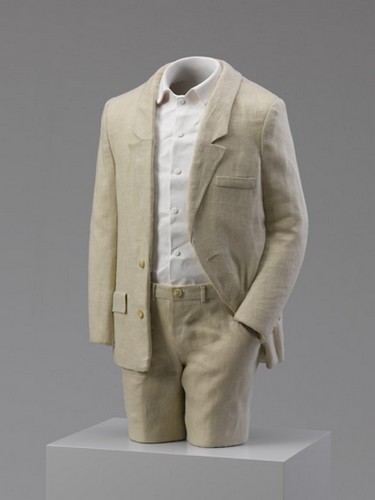Erwin Wurm
29 Aug - 02 Oct 2009
ERWIN WURM
”Desperate Philosophers”
August 29 - October 2, 2009
Galerie Thaddaeus Ropac takes pleasure in announcing the exhibition Desperate Philosophers by Erwin Wurm. This series of sculptures, created especially for the exhibition, is being shown in public for the first time.
Erwin Wurm summarises the basic idea thus: "It deals with the difficulty of mastering life, regardless of whether we do so with the aid of philosophy or of a nutritional diet." On closer inspection of the sculptures, we see that this series combines various aspects of Erwin Wurm's work.
The very title, Desperate Philosophers, implies that the idea for the works originates in Wurm's study of philosophy. He is not alone in considering that the philosopher and the artist have much in common. They are concerned with everyday life, with the multifarious levels of reality, and they see failure mostly not as something negative. On the contrary - failure is often a driving force from which their creative power can evolve.
A further approach that becomes clear in the sculptures is the idea that the power of the intellect can change reality, and thus objects or people. Similarly to his works from the Hypnosis series, which show probably most clearly how a psychological state determines a person's physical condition, the Philosophers reveal the interrelation between idea and reality, or rather, what becomes reality through being thought or felt.
From this point of view, the Philosophers also follow on from the "Ärgerbeulen" [lit. "trouble swellings"] sculpture series, which shows people with clearly visible deformations. Just as Pinocchio's nose grows when he tells a lie, these sculptures develop swellings in various parts of the body. The force with which they bulge out of the body bursts open the clothes, while the person himself remains calm. The Philosophers have pumpkins growing out of their heads; they have cylindrical bodies or drawings on their naked skin; they have lost individual body parts, especially the head, the very part used for thinking.
Wurm uses physical deformation to make clear how a psychological process can result in a physical change. At the same time, these new works show overlapping ideas which have preoccupied the artist for some time: themes such as mass, volume and surface. The exhibition also includes new paintings and drawings.
”Desperate Philosophers”
August 29 - October 2, 2009
Galerie Thaddaeus Ropac takes pleasure in announcing the exhibition Desperate Philosophers by Erwin Wurm. This series of sculptures, created especially for the exhibition, is being shown in public for the first time.
Erwin Wurm summarises the basic idea thus: "It deals with the difficulty of mastering life, regardless of whether we do so with the aid of philosophy or of a nutritional diet." On closer inspection of the sculptures, we see that this series combines various aspects of Erwin Wurm's work.
The very title, Desperate Philosophers, implies that the idea for the works originates in Wurm's study of philosophy. He is not alone in considering that the philosopher and the artist have much in common. They are concerned with everyday life, with the multifarious levels of reality, and they see failure mostly not as something negative. On the contrary - failure is often a driving force from which their creative power can evolve.
A further approach that becomes clear in the sculptures is the idea that the power of the intellect can change reality, and thus objects or people. Similarly to his works from the Hypnosis series, which show probably most clearly how a psychological state determines a person's physical condition, the Philosophers reveal the interrelation between idea and reality, or rather, what becomes reality through being thought or felt.
From this point of view, the Philosophers also follow on from the "Ärgerbeulen" [lit. "trouble swellings"] sculpture series, which shows people with clearly visible deformations. Just as Pinocchio's nose grows when he tells a lie, these sculptures develop swellings in various parts of the body. The force with which they bulge out of the body bursts open the clothes, while the person himself remains calm. The Philosophers have pumpkins growing out of their heads; they have cylindrical bodies or drawings on their naked skin; they have lost individual body parts, especially the head, the very part used for thinking.
Wurm uses physical deformation to make clear how a psychological process can result in a physical change. At the same time, these new works show overlapping ideas which have preoccupied the artist for some time: themes such as mass, volume and surface. The exhibition also includes new paintings and drawings.

